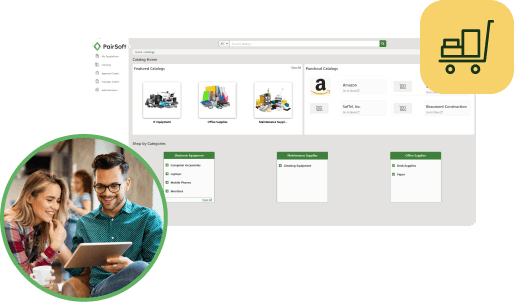
PairSoft
The strongest AP automation, document management, procurement, and fundraising automation platform for mid-market and enterprise companies with integrations to your ERP system.
View all posts by PairSoftPairSoft

For the past several weeks we’ve been walking through the various steps in the procurement cycle, starting with recognizing the need for a product or service, approving the spend, identifying sourcing, pricing, and terms, ordering and then receiving the product, and lastly, invoice approval and payment. There’s another, important element of the procurement cycle that isn’t really a separate step at all. It is (or should be!) an integrated part of the process. It’s proper and thorough record keeping. Keeping clear and auditable records of your company’s purchasing activities is vital, yet it can be a time consuming and largely manual process if you aren’t using a procurement application. As we wrap up our procurement basics series, we look at five ways that procurement software makes maintaining a comprehensive audit trail of the procurement process an integrated part of doing business.
While virtually all companies maintain a record of their purchases, the savvy ones are migrating those records to electronic format, and pushing their suppliers and customers to do the same. Many of your company’s procurement documents may already be in electronic format, but those that are not should be scanned using Optical Character Recognition (OCR). Procurement solutions will allow you to associate various files with procurement documents, keeping relevant information together and easily accessible. For example, vendor contracts, product warranties, bills of lading, or customs declaration forms can be saved and associated with a purchase order.
Manually handling and routing documents requires a lot of time and money—in the form of storage space, printing, filing, and staffing in order to maintain an organized record system. It also takes a lot of time and money to search or reproduce lost records. Procurement software minimizes (or even removes) the need for paper handling, driving efficiency through every step of the procurement process. Whenever possible, consider issuing a master vendor contract to your major suppliers, so that they are contracted to supply your products at the prices and terms agreed. With a vendor contract in place, you can track committed amounts and quantities against the master contract, and manage the approval process should those limits get tested.
Increasingly, vendors are foregoing paper invoices and sending electronic invoices. When invoices arrive in electronic format, they can be easily tagged, flagged, coded, routed, and associated with your internal documents, such as a purchase order and check request. When the paper invoice arrives, the document can be scanned using OCR and then associated with your internal documents and follow the same path as an electronic invoice. Many procurement solutions offer self-service vendor portals, where vendors can upload their own invoices, which the software then routes for approvals according to the rules and workflows you’ve established. This further streamlines the process, by placing the impetus for entering and submitting invoices on your suppliers. To put the state of electronic invoicing in perspective, a 2018 Payables Insights report published by PayStream Advisors, found that among the companies they surveyed, 36% of invoices still arrive as paper documents, with 34% arriving via email as PDFs, with the balance of invoices arriving through EDI (15%), or through a supplier portal (15%).
The benefits of keeping extensive records of your company’s spend go beyond accounting best practices. When you begin capturing detailed data about what you buy, whom you buy it from, how much you pay, and when you buy it, you can analyze that data and use it to improve budgeting and long-term forecasting, and even negotiate better terms with vendors by pre-purchasing or committing to a specific quantity. By capturing detailed spending data from start to finish, procurement solutions allow you to more easily explore and leverage your data, establishing spending benchmarks and providing insight into long-term spending patterns.
In a paper-based procurement system, it might be nearly impossible to determine what changes were made to various documents, when they were made, or who made them. In an electronic procurement system, the software captures detailed transaction line and field level changes, keeping an audit log of every action through the transaction lifecycle. This audit capability is a hallmark best practice of accounting, and beyond that, it’s just smart to know who’s doing what. Well-organized procurement records provide a reliable, legally verifiable source of evidence of decisions and actions taken by your organization over time. Those same records may also be used to make better, more informed decisions about the entire procure-to-pay process. And the best part is that this level of record keeping is an inherent part of procurement software, requiring zero effort on your part. See procurement in action here.
Talk to an expert today to uncover how your team’s procurement stacks up against the top performers in your sector.



Many organizations start with manual receipt handling, fragmented card feeds and slow AP processes. Implement AI agents to auto-capture receipts, route approvals, enable punch-out buys and post to the ERP.
Result: faster batching, fewer errors and cost savings. “This saves us hours every month.”
Many organizations face slow, paper-heavy AP and fragmented procurement that waste time and inflate costs. AI Agents can automate approvals, PO matching and record sync to improve speed, accuracy and control. Client quote: “It freed up hours and made our process reliable.”
Operational drag and rising costs slow growth: teams waste time on manual tasks, misaligned priorities and opaque processes. AI Agents help automate routine work and coordinate actions across teams. “We’ve lost time to repeats and handoffs,” says a typical client.
Companies struggle with manual procurement, fragmented approvals, and costly integrations that slow growth and obscure spend. Our AI Agents streamline requisitions, POs, and invoice matching to cut manual work and improve visibility. “We were wasting time and missing insights,” says a client.

Many teams start with fragmented PO/AP systems, manual matching and delayed financial reporting. Deploying AI agents to automate PO checks, real-time encumbrance tracking and invoice matching reduces processing time and errors, delivering live budgets and faster closes. “Finally, we can see current balances and approve instantly.”
Many companies juggle growing invoice volumes and legacy systems. They struggle with manual processes, compliance gaps and limited headcount. Our AI Agents automate integrations, enforce rules and surface exceptions. The typical outcome: faster closes and measurable ROI. “We stopped chasing invoices.”